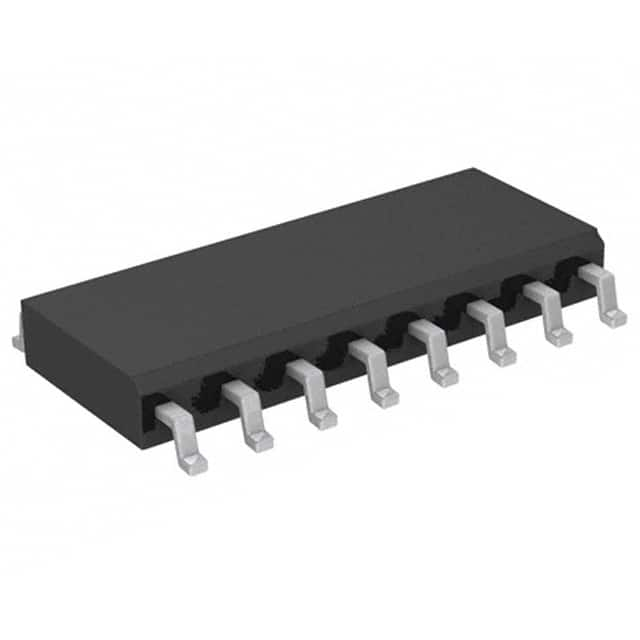Viz Specifikace pro podrobnosti o produktu.

74HC4051D,653
Product Overview
Category
The 74HC4051D,653 belongs to the category of integrated circuits (ICs).
Use
This IC is commonly used as a multiplexer/demultiplexer in various electronic applications.
Characteristics
- The 74HC4051D,653 is a high-speed CMOS device.
- It operates at a voltage range of 2V to 6V.
- This IC has eight channels for analog or digital signals.
- It offers low power consumption and high noise immunity.
- The 74HC4051D,653 is compatible with TTL levels.
Package
The 74HC4051D,653 is available in a standard SOIC (Small Outline Integrated Circuit) package.
Essence
The essence of the 74HC4051D,653 lies in its ability to select one input from multiple sources and route it to a single output.
Packaging/Quantity
This IC is typically sold in reels or tubes, with a quantity of 2500 units per reel or 98 units per tube.
Specifications
- Supply Voltage: 2V to 6V
- Input Voltage: 0V to VCC
- Output Voltage: 0V to VCC
- On-state Resistance: 125Ω (typical)
- Channel-to-channel Crosstalk: -80dB (typical)
- Operating Temperature Range: -40°C to +125°C
Detailed Pin Configuration
The 74HC4051D,653 has 16 pins arranged as follows:
___________
| |
1 | A0 | 16
2 | A1 | 15
3 | A2 | 14
4 | E | 13
5 | Y0 | 12
6 | Y1 | 11
7 | Y2 | 10
8 | VCC | 9
|___________|
Functional Features
- The 74HC4051D,653 acts as a bidirectional multiplexer/demultiplexer.
- It allows the selection of one input from multiple sources and routes it to the output.
- This IC can be used for both analog and digital signals.
- It offers low power consumption and high noise immunity.
- The 74HC4051D,653 has an enable pin (E) to control the operation.
Advantages and Disadvantages
Advantages
- High-speed CMOS technology ensures fast data transmission.
- Wide operating voltage range allows compatibility with various systems.
- Low power consumption makes it suitable for battery-powered devices.
- High noise immunity ensures reliable signal transmission.
Disadvantages
- Limited number of channels (eight channels).
- On-state resistance may affect signal quality in certain applications.
- Not suitable for high-frequency applications due to limited bandwidth.
Working Principles
The 74HC4051D,653 operates based on the principle of multiplexing. When the enable pin (E) is high, the IC selects one of the inputs (A0-A2) based on the binary address applied to these pins. The selected input is then routed to the corresponding output (Y0-Y2). The remaining inputs are disconnected from the output.
Detailed Application Field Plans
The 74HC4051D,653 finds applications in various fields, including:
- Audio/Video Switching: It can be used to select different audio or video sources in multimedia systems.
- Data Acquisition Systems: This IC enables the multiplexing of analog signals in data acquisition systems.
- Communication Systems: It can be used for signal routing and switching in communication equipment.
- Industrial Automation: The 74HC4051D,653 is suitable for controlling multiple sensors or actuators in industrial automation systems.
Detailed and Complete Alternative Models
Some alternative models to the 74HC4051D,653 are:
- CD4051B: Similar multiplexer/demultiplexer IC from Texas Instruments.
- HEF4051BP: Equivalent CMOS device from NXP Semiconductors.
- MC14051B: Analog multiplexer/demultiplexer IC from ON Semiconductor.
These alternative models offer similar functionality and can be used as replacements for the 74HC4051D,653 in various applications.
In conclusion, the 74HC4051D,653 is a versatile multiplexer/demultiplexer IC with eight channels. It offers high-speed operation, low power consumption, and compatibility with various voltage levels. Its applications range from audio/video switching to industrial automation. While it has some limitations, alternative models are available to suit specific requirements.
Seznam 10 běžných otázek a odpovědí souvisejících s aplikací 74HC4051D,653 v technických řešeních
Sure! Here are 10 common questions and answers related to the application of 74HC4051D,653:
Q1: What is the 74HC4051D,653? A1: The 74HC4051D,653 is a multiplexer/demultiplexer IC (Integrated Circuit) that allows multiple analog or digital signals to be routed through a single pin.
Q2: What is the purpose of using the 74HC4051D,653? A2: The 74HC4051D,653 is commonly used in technical solutions to select between multiple input signals and route them to a single output, or vice versa.
Q3: How many channels does the 74HC4051D,653 have? A3: The 74HC4051D,653 has 8 channels, which means it can handle up to 8 different input/output signals.
Q4: What is the voltage range supported by the 74HC4051D,653? A4: The 74HC4051D,653 supports a wide voltage range from 2V to 10V, making it compatible with various digital and analog systems.
Q5: Can the 74HC4051D,653 handle both analog and digital signals? A5: Yes, the 74HC4051D,653 is designed to handle both analog and digital signals, making it versatile for different applications.
Q6: How do I control the channel selection on the 74HC4051D,653? A6: The channel selection is controlled by providing binary inputs to the address pins (A, B, C). These inputs determine which channel is active.
Q7: What is the maximum current rating of the 74HC4051D,653? A7: The 74HC4051D,653 has a maximum current rating of 25mA per channel, which should be considered when connecting external devices.
Q8: Can I cascade multiple 74HC4051D,653 ICs together? A8: Yes, you can cascade multiple 74HC4051D,653 ICs to increase the number of channels and expand the routing capabilities.
Q9: Is the 74HC4051D,653 suitable for high-frequency applications? A9: The 74HC4051D,653 is not specifically designed for high-frequency applications. It is more commonly used in low to moderate frequency systems.
Q10: Are there any specific precautions to consider when using the 74HC4051D,653? A10: It is important to ensure that the voltage levels applied to the inputs and outputs of the 74HC4051D,653 are within the specified range to prevent damage to the IC. Additionally, proper decoupling capacitors should be used to minimize noise and stabilize the power supply.
Please note that these answers are general and may vary depending on the specific application and requirements. Always refer to the datasheet and consult with an expert when designing technical solutions.

